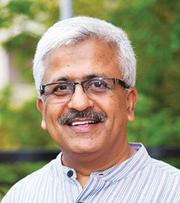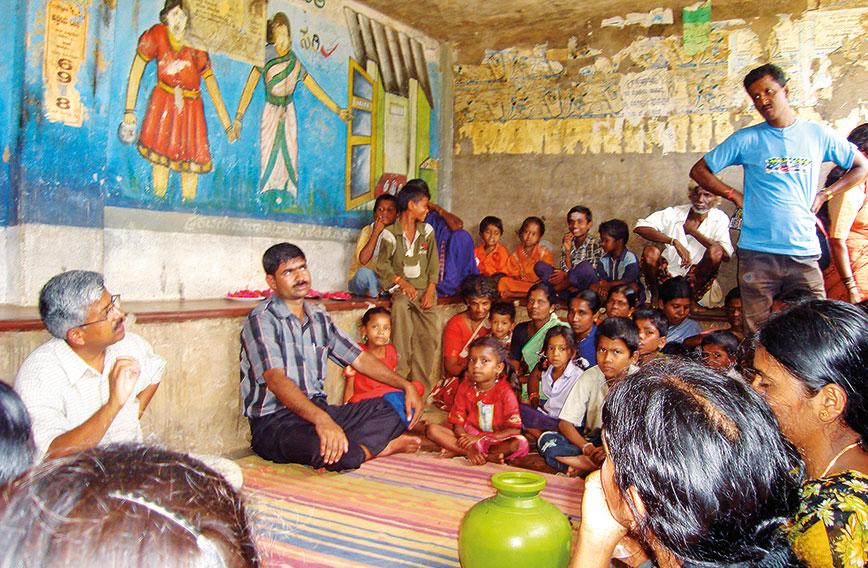
R BALASUBRAMANIAM
A few months ago, I was taken by a friend who works with an NGO to visit a special school near Jamshedpur which they were running. She had been talking about this school for some time and was eager that I visit it to see for myself how educational opportunities could change the lives of children.
Keen to see what made this school special, I was astonished at what I saw. A special school can mean so many things to different people — it can be special for its pedagogy or infrastructure or teaching-learning methods. Or because of the children themselves. This school was special for all these reasons and much more.
At the entrance we noticed outdoor play equipment made with low-cost material and discarded car tyres. And most of it seemed to be the handiwork of the children themselves. As we stepped inside, we were greeted by simple but profoundly meaningful sketches and paintings done by the children. Each painting seemed to tell a story and they were all reflective of the emotions and hopes of the children.
But the icing on the cake was the children themselves. They came from very difficult and challenging backgrounds and had either never been to a formal school or only for a few months in their entire lives. They were between 10 and 16 years old. I realised that this was not a school in the real sense of the word. It was a shelter home for children who had run away from their homes or from difficult circumstances. They were children whom the State had to protect and take care of as they could not yet locate their families.
I would never have gotten to know this if one of the teachers had not specifically told me. For, these children looked cheerful, happy and their eyes were sparkling with joy. Their hearts were filled with hope and excitement.They were surely not the stereotypes that I had expected and they were all eager to talk and interact with me. Each had his own special story to tell. Ramu explained in a matter of fact way that he was from Mumbai and had run away from his home as he could no longer bear to see his mother getting beaten by his drunken father every day. He had decided to teach his father a lesson and had beaten him with a lathi that he had found nearby. Afraid of the consequences, he travelled by several trains and reached faraway Jamshedpur.
Subash explained how he was picking rags in the street and some local government officials had whisked him away to this place. Another child had been working in a tea shop and yet another in a mechanic’s garage. Despite the differing backgrounds that they came from or the languages they spoke, all of them seemed to love the bridge school that some were attending while the others were feeling settled in the regular schools to which they had been mainstreamed. None of them missed their earlier lives and seemed eager to move on in life. One child spoke of how, for the first time in his nine-year-old life, he was actually getting to eat three times a day. Another child said he loved how he could now hold on to a bat and play cricket and kick around a ‘real’ football.
While all these stories may sound similar to those of thousands of children across the country, we need to ask ourselves if we, as a society, have done enough for them. Why is it that after so many years of making primary education compulsory, seeing steady economic growth nationally and several child welfare schemes in operation, we are still grappling with issues related to child labour, poverty and trafficking? Gandhi had said that a society will be judged on how well it takes care of its marginalised and deprived sections. While governments and NGOs are doing what they can to manage this issue, why is it that we have not been able to obliterate this scourge of child labour and other deprivations that deny our children what they rightfully deserve — their childhood.
According to Census 2011, the child population in India between five and 14 years old is 259.6 million. Of these, 10.1 million (3.9 percent of the total child population) are working, either as a ‘main worker’ or as a ‘marginal worker’. In addition, more than 42.7 million children in India are out of school. Child labour impedes children from gaining the skills and education they need to access opportunities of decent work as adults. Inequality, lack of educational opportunities,
slow demographic transition, traditions and cultural expectations all contribute to the persistence of child labour in India. The International Labour Organisation’s experience is that stable economic growth, respect for labour standards, decent work, universal education, social protection, and recognising the needs and rights of children together help tackle the root causes of child labour. Will India be able to ensure all this for our children and provide them with the security of growing up in a nurturing environment irrespective of their social and economic status?
While the incidence of child labour has decreased in India by 2.6 million between 2001 and 2011, what is of concern is that this decline is mainly seen in rural areas. The number of child workers has actually increased in urban areas, indicating the growing demand for child workers for menial jobs. As India continues to rapidly urbanise and our economy gets driven by the urban engine, we need to intensify our battle against child labour. Governments alone or mere legislation is not going to solve this issue. The fight now needs to be embedded in our collective consciousness. A concerted effort by every citizen can ensure that fighting child labour goes beyond mere sloganeering. As Rabbi Hillel says, “If I am not for myself, who will be for me? If I am not for others, what am I? And if not now, when?”
Dr R. Balasubramaniam, founder of the Swami Vivekananda Youth Movement, Mysuru, is a development activist and author. www.drrbalu.com
Comments
Currently there are no Comments. Be first to write a comment!




